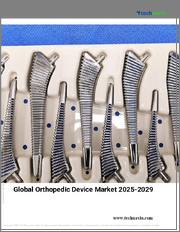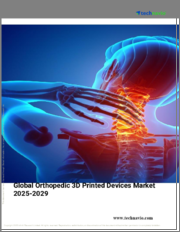
|
시장보고서
상품코드
1627984
정형외과 기기 시장 기회, 성장 촉진요인, 산업 동향 분석, 예측(2024-2032년)Orthopedic Devices Market Opportunity, Growth Drivers, Industry Trend Analysis, and Forecast 2024 to 2032 |
||||||
세계 정형외과 기기 시장은 2023년 523억 달러로 평가되며, 2024년부터 2032년까지 연평균 3.8%의 성장률을 보일 것으로 예측됩니다.
인구 고령화, 근골격계 질환의 유병률 증가, 의료 기술의 급속한 발전이 시장 확대에 기여하고 있습니다.
3D 프린팅 임플란트, 맞춤형 정형외과 기기, 로봇 보조 수술기구 등의 개발은 정확도를 높이고 환자 결과를 개선하는 등 기술 혁신이 시장 성장에 매우 중요한 역할을 하고 있습니다. 이러한 발전으로 외과의사는 복잡한 수술을 보다 정밀하게 수행할 수 있게 되었으며, 회복 시간을 단축하고 환자 만족도를 높일 수 있게 되었습니다. 최소침습 수술법의 채택이 증가하고 있는 것도 큰 기여를 하고 있습니다. 이러한 수술은 위험 감소, 입원 기간 단축, 빠른 회복을 제공하기 때문에 환자와 의료 서비스 제공자 사이에서 점점 더 인기를 얻고 있습니다.
시장은 제품별로 외상 고정 기구, 관절경 기구, 재건 기구, 척추 기구, 정형외과용 생물학적 제제, 기타로 나뉩니다. 관절 재건 기기는 2032년까지 4.5%의 CAGR로 291억 달러에 달할 것으로 예상되며, 강력한 성장이 예상됩니다. 이 부문의 성장은 특히 노년층의 정형외과 질환 발병률 증가가 주요 요인으로 작용하고 있습니다. 골관절염 및 퇴행성 관절 질환과 같은 질병이 점점 더 흔해지면서 관절 재건 수술에 대한 수요가 급증하고 있습니다.
| 시장 범위 | |
|---|---|
| 시작 연도 | 2023년 |
| 예측 연도 | 2024-2032 |
| 시작 금액 | 523억 달러 |
| 예상 금액 | 734억 달러 |
| CAGR | 3.8% |
최종 사용처에 따라 병원 및 클리닉, 외래 수술 센터, 기타 시설로 분류됩니다. 병원 및 클리닉이 시장을 장악하고 있으며, 2032년까지 402억 달러의 매출을 기록할 것으로 예상됩니다. 이들 시설은 첨단 수술 능력, 종합적인 영상 및 진단 도구, 종합적인 재활 서비스 등을 갖추고 있어 정형외과 의료의 주요 공급자로 자리매김하고 있습니다. 병원은 전문 장비와 전문 지식을 갖추고 있기 때문에 복잡한 정형외과적 사례에 대한 양질의 치료를 보장합니다.
지역별로는 북미가 2023년 293억 달러의 시장 매출을 차지할 것으로 예상되며, 2024년부터 2032년까지 연평균 3%의 성장률을 보일 것으로 전망됩니다. 이 지역의 성장 원동력은 노인 인구가 많고 근골격계 질환의 유병률이 높기 때문입니다. 고령화가 진행됨에 따라 관절염 및 골다공증과 같은 질병이 만연하여 정형외과적 개입에 대한 수요가 증가하고 있습니다. 또한, 북미의 선진화된 의료 인프라와 혁신적인 수술 기법에 대한 관심은 최첨단 정형외과 기기의 채택을 지원하며 시장 확대를 더욱 촉진하고 있습니다.
결론적으로, 정형외과 기기 시장은 기술 발전, 노인 인구 증가, 효과적인 정형외과 치료 솔루션에 대한 수요 증가를 배경으로 꾸준히 성장할 것으로 보입니다.
목차
제1장 조사 방법과 조사 범위
제2장 주요 요약
제3장 업계 인사이트
- 생태계 분석
- 업계에 대한 영향요인
- 성장 촉진요인
- 노인 인구 증가
- 정형외과 질환 증가
- 기술의 진보
- 선진국의 정형외과 수술률 상승
- 업계의 잠재적 리스크와 과제
- 정형외과 기기의 과대한 비용
- 엄격한 FDA 규제와 생체적합성 문제
- 성장 촉진요인
- 성장 가능성 분석
- 기술 전망
- 공급망 분석
- 향후 시장 동향
- 규제 상황
- 상환 시나리오
- 투자 개요
- Porters 분석
- PESTEL 분석
제4장 경쟁 구도
- 소개
- 기업 점유율 분석
- 기업 매트릭스 분석
- 주요 시장 기업 경쟁 분석
- 경쟁 포지셔닝 매트릭스
- 전략 대시보드
제5장 시장 추정과 예측 : 제품별, 2021-2032년
- 주요 동향
- 관절 재건 기기
- 고관절 치환술
- 슬관절 치환술
- 발목관절 치환술
- 견관절 치환술
- 기타 관절 재건 기기
- 척추 기기
- 외상 고정 기기
- 오소바이오로직스
- 관절경
- 기타 제품
제6장 시장 추정과 예측 : 최종사용자별, 2021-2032년
- 주요 동향
- 병원·클리닉
- 외래 수술 센터
- 기타 최종사용자
제7장 시장 추정과 예측 : 지역별, 2021-2032년
- 주요 동향
- 북미
- 미국
- 캐나다
- 유럽
- 독일
- 영국
- 프랑스
- 스페인
- 이탈리아
- 네덜란드
- 아시아태평양
- 중국
- 일본
- 인도
- 호주
- 한국
- 라틴아메리카
- 브라질
- 멕시코
- 아르헨티나
- 중동 및 아프리카
- 남아프리카공화국
- 사우디아라비아
- 아랍에미리트
제8장 기업 개요
- aap Implantate
- Alphatec Spine
- Arthrex
- B. Braun
- ConforMIS
- CONMED
- DePuy Synthes(Johnson and Johnson)
- DJO Global
- Globus Medical
- Integra LifeSciences
- Medacta
- Medtronic
- Microport Scientific
- NuVasive
- Smith & Nephew
- Stryker
- TriMed
- Waldemar LINK
- Zimmer Biomet
The Global Orthopedic Devices Market reached USD 52.3 billion in 2023 and is projected to grow at a CAGR of 3.8% from 2024 to 2032. The market's expansion is fueled by an aging population, increasing prevalence of musculoskeletal disorders, and rapid advancements in medical technology.
Technological innovations are playing a pivotal role in driving market growth. Developments such as 3D-printed implants, personalized orthopedic devices, and robotic-assisted surgical tools are enhancing precision and improving patient outcomes. These advancements are enabling surgeons to perform complex procedures with greater accuracy, leading to faster recovery times and improved patient satisfaction. The growing adoption of minimally invasive surgical techniques contributes significantly, as these procedures offer reduced risks, shorter hospital stays, and quicker recoveries, making them increasingly popular among patients and healthcare providers.
The market is segmented by product into trauma fixation devices, joint arthroscopic devices, reconstruction devices, spinal devices, ortho biologics, and others. Joint reconstruction devices are poised for strong growth, with a CAGR of 4.5% expected through 2032, reaching USD 29.1 billion. This segment's expansion is primarily driven by the rising incidence of orthopedic conditions, particularly among the elderly. Conditions such as osteoarthritis and degenerative joint diseases are increasingly common, leading to a surge in demand for joint reconstruction procedures.
| Market Scope | |
|---|---|
| Start Year | 2023 |
| Forecast Year | 2024-2032 |
| Start Value | $52.3 Billion |
| Forecast Value | $73.4 Billion |
| CAGR | 3.8% |
By end use, the market is categorized into hospitals & clinics, ambulatory surgical centers, and other facilities. Hospitals and clinics dominate the market, with their revenue expected to reach USD 40.2 billion by 2032. These institutions are key providers of orthopedic care due to their advanced surgical capabilities, comprehensive imaging and diagnostic tools, and integrated rehabilitation services. The availability of specialized equipment and expertise in hospitals ensures high-quality care for complex orthopedic cases.
Geographically, North America accounted for USD 29.3 billion in market revenue in 2023 and is projected to grow at a CAGR of 3% from 2024 to 2032. The region's growth is driven by a substantial elderly population and a high prevalence of musculoskeletal disorders. As the aging population increases, conditions like arthritis and osteoporosis become more widespread, boosting demand for orthopedic interventions. Additionally, North America's advanced healthcare infrastructure and focus on innovative surgical techniques support the adoption of cutting-edge orthopedic devices, further propelling market expansion.
In conclusion, the orthopedic devices market is set for steady growth, driven by technological advancements, a growing elderly population, and increasing demand for effective orthopedic care solutions.
Table of Contents
Chapter 1 Methodology & Scope
- 1.1 Market scope & definitions
- 1.2 Research design
- 1.2.1 Research approach
- 1.2.2 Data collection methods
- 1.3 Base estimates & calculations
- 1.3.1 Base year calculation
- 1.3.2 Key trends for market estimation
- 1.4 Forecast model
- 1.5 Primary research and validation
- 1.5.1 Primary sources
- 1.5.2 Data mining sources
Chapter 2 Executive Summary
- 2.1 Industry 360° synopsis
Chapter 3 Industry Insights
- 3.1 Industry ecosystem analysis
- 3.2 Industry impact forces
- 3.2.1 Growth drivers
- 3.2.1.1 Growing base of geriatric population
- 3.2.1.2 Augmented incidence of orthopedic diseases
- 3.2.1.3 Technological advancements
- 3.2.1.4 Escalating rate of orthopedic surgeries in developed nations
- 3.2.2 Industry pitfalls & challenges
- 3.2.2.1 Excessive cost of orthopedic devices
- 3.2.2.2 Stringent FDA regulations and biocompatibility issues
- 3.2.1 Growth drivers
- 3.3 Growth potential analysis
- 3.4 Technology landscape
- 3.5 Supply chain analysis
- 3.6 Future market trends
- 3.7 Regulatory landscape
- 3.8 Reimbursement scenario
- 3.9 Investment overview
- 3.10 Porter's analysis
- 3.11 PESTEL analysis
Chapter 4 Competitive Landscape, 2023
- 4.1 Introduction
- 4.2 Company market share analysis
- 4.3 Company matrix analysis
- 4.4 Competitive analysis of major market players
- 4.5 Competitive positioning matrix
- 4.6 Strategy dashboard
Chapter 5 Market Estimates and Forecast, By Product, 2021 - 2032 ($ Mn)
- 5.1 Key trends
- 5.2 Joint reconstruction devices
- 5.2.1 Hip replacement
- 5.2.2 Knee replacement
- 5.2.3 Ankle replacement
- 5.2.4 Shoulder replacement
- 5.2.5 Other joint reconstruction devices
- 5.3 Spinal devices
- 5.4 Trauma fixation devices
- 5.5 Orthobiologics
- 5.6 Arthroscopic devices
- 5.7 Other products
Chapter 6 Market Estimates and Forecast, By End Use, 2021 - 2032 ($ Mn)
- 6.1 Key trends
- 6.2 Hospitals & clinics
- 6.3 Ambulatory surgical centers
- 6.4 Other end users
Chapter 7 Market Estimates and Forecast, By Region, 2021 - 2032 ($ Mn)
- 7.1 Key trends
- 7.2 North America
- 7.2.1 U.S.
- 7.2.2 Canada
- 7.3 Europe
- 7.3.1 Germany
- 7.3.2 UK
- 7.3.3 France
- 7.3.4 Spain
- 7.3.5 Italy
- 7.3.6 Netherlands
- 7.4 Asia Pacific
- 7.4.1 China
- 7.4.2 Japan
- 7.4.3 India
- 7.4.4 Australia
- 7.4.5 South Korea
- 7.5 Latin America
- 7.5.1 Brazil
- 7.5.2 Mexico
- 7.5.3 Argentina
- 7.6 Middle East and Africa
- 7.6.1 South Africa
- 7.6.2 Saudi Arabia
- 7.6.3 UAE
Chapter 8 Company Profiles
- 8.1 aap Implantate
- 8.2 Alphatec Spine
- 8.3 Arthrex
- 8.4 B. Braun
- 8.5 ConforMIS
- 8.6 CONMED
- 8.7 DePuy Synthes (Johnson and Johnson)
- 8.8 DJO Global
- 8.9 Globus Medical
- 8.10 Integra LifeSciences
- 8.11 Medacta
- 8.12 Medtronic
- 8.13 Microport Scientific
- 8.14 NuVasive
- 8.15 Smith & Nephew
- 8.16 Stryker
- 8.17 TriMed
- 8.18 Waldemar LINK
- 8.19 Zimmer Biomet



















